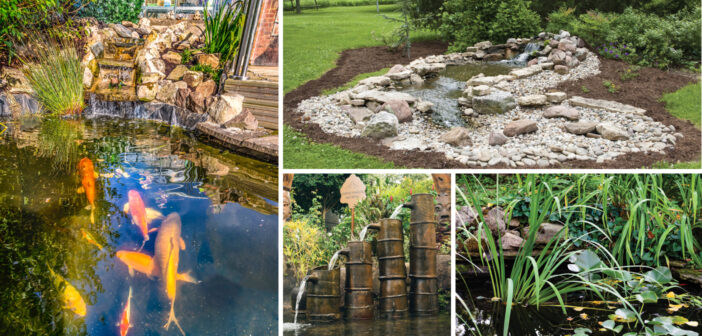One of the most adventurous ways to add character and beauty to your backyard is to install a pond. We, as humans, love being near water. There is something about watching the wind ripple the surface or watching the fish swim that can bring a sense of calm or serenity to an otherwise chaotic day. If done right, your new aquatic habitat will be filled with natural beauty. It can take a little more work than you thought, but the final result will continue to pay dividends far into the future.
Once you have decided that a pond is for you, don’t just run outside and start digging a hole all willy-nilly. There are things you should consider and plan for before breaking ground. Planning and preparation are key.
Here are tips for building your perfect backyard water world.
1. Location, location, location.
The spot you choose to create your pond can determine what plants to incorporate and whether or not it can support aquatic life. A pond works best in a location that receives at least six hours of uninterrupted sunlight a day, yet still receives a small amount of afternoon shade. Sunlight is most necessary if you want to stock your small pond with fish.
2. Plan for accessibility.
Don’t just start digging. Make a plan. Choose an area that allows access to all sides. If you locate your pond against a fence, wall or hedge, you may not be able to easily tend that part of the pond. Leave a workspace of at least two feet all around the pond.
3. Make access INTO the pond easier.
There may come a time when you have to physically enter your pond. Start to make things easier for your future self by cutting steps into the soil during excavation. The steps can act as shelves for rocks and plants. Digging a slope as access can actually make it much harder to get in without damaging the ecosystem.
4. Consider the seasons.
In the early phase of construction, many questions need to be answered and possibilities considered. If you are going to add fish to your pond, the question of what happens during winter becomes important. The best thing to do is to make sure your pond is deep enough so that fish can hibernate and survive. In Michigan, it is best to make your pond 30 inches deep, although 18 inches may work, if the weather is usually mild in your area. Make sure to pick plant life that will continue to thrive after the winter ends.
5. What about emptying?
Make your pond easy to empty. Nobody likes to have to move a water pump multiple times in a mucky pond. When excavating, identify the lowest spot and slope the floor toward it. The lowest spot should be disc-shaped and three inches deeper than the rest of the pond. This is where you will locate your water pump in the event the pond needs to be cleared.
6. Your liner matters.
Yes, your pond should be lined and the thicker the liner, the better it will be. It is recommended to use a tough EPDM (Ethylene Propylene Diene Monomer) liner with a thick underlayment. Consider using old carpet padding as an underlayment to block pebbles and other sharp objects from damaging the liner.
7. Block unwanted plants.
Plants want to get into everything and can really muck up the beauty you have carefully cultivated in your pond. A big step to warding off unwanted plants is to extend your liner approximately 12 inches beyond the pond’s edge, then cover it with mulch or gravel. This will act as a shield that will keep anything from getting too close.
8. Keep the water in.
Once your pond is lined and edges known, make plans to build a curb before filling. The curb should be built up to at least three inches above the edge to stop runoff from getting into the pond and keep the pond from getting out. If this is neglected, you may find your fish out of water after a large storm.
9. Plan for maintenance.
Ponds are great but MUST be maintained. There is no such thing as a self-maintained pond. Large ponds are easier to maintain than small ponds because with more space, nature can pick up some of the slack. Fish need to be fed, filters need to be cleaned and sometimes, vermin must be removed.
10. Spark circulation.
There are multiple ways to keep the pond water oxidized and well-circulated. This will cut down on algae growth and help control the mosquito population. A stagnant pond is a dirty pond. Consider adding a unique feature, like a waterfall. You are already putting in the work, so may as well go all the way! A waterfall can be just the thing that turns your pond into a work of art.
5 Quick Waterfall Tips
Your pond is ready to go and it’s time for the finishing touch – a splendid, little waterfall. Here are a few quick tips for making it great.
- If possible, make the waterfall visible from inside your home.
- Consider adding twists and turns to the water’s route.
- Soften the edges of your new river with plant life.
- Frame the falls with your largest rocks.
- Take your cue from nature and recreate a natural fall on a smaller scale.














